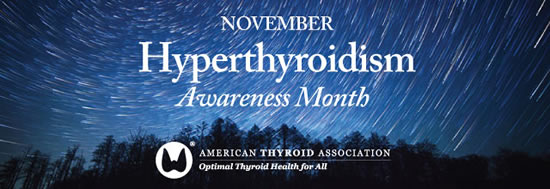
Clinical Thyroidology for the Public summarizes selected research studies discussed in the previous month’s issue of Clinical Thyroidology, an official publication of the American Thyroid Association. Editor-in-chief, Alan Farwell, MD, FACE
Volume 16 Issue 11
Available in pdf format for saving and printing and Web page format for viewing online
PDF Format for Saving and Printing
Clinical Thyroidology for the Public Volume 16 Issue 11 (PDF file, 2.79MB)
TABLE OF CONTENTS – Web Format
HYPERTHYROIDISM
Timely and appropriate treatment of amiodarone-induced thyrotoxicosis is important to decrease heart complications.
Amiodarone-induced thyrotoxicosis (AIT) can be difficult to treat because there are two different types that need different treatments. Since patients who are treated with amiodarone have underlying heart disease, it is important to quickly control thyrotoxicosis in these patients to minimize its impact on heart. This study examined whether the initial treatment received by patients with AIT affects cardiovascular outcomes.
Cappellani D et al 2023 Real-life data on the effect of medical therapy for amiodarone-induced thyrotoxicosis on CV events and hospitalizations. J Clin Endocrinol Metab 108:1298–1307. PMID: 36585895.
THYROID SURGERY
Older people have more complications after thyroid surgery than younger individuals
Studies done in the past have tried to figure out if older people who have thyroid surgery are more likely than younger people to suffer those complications but the results were mixed. Some studies showed more complications and some reported no difference. This study tries to determine if there is a difference in complications of thyroid surgery between patients in their 80s (octogenarians) and younger patients
Sakowitz S et al 2023 Thyroid surgery outcomes in octogenarians: A national analysis. Surgery. Epub 2023 Apr 11. PMID: 37055292
THYROID NODULE
Possible age cutoff may predict growth of small, suspicious appearing thyroid nodules.
Monitoring of small cancers by ultrasound instead of pursuing surgery, called active surveillance, has become an accepted treatment option. Similarly, active surveillance without biopsy is recommended for small nodules <1 cm, even if these nodules have suspicious features on ultrasound. This study was done to determine if there is a specific age cutoff that would help predict the risk of significant growth of small suspicious nodules.
Zhuge, L et al 2023. The optimal age threshold for stratifying the risks of disease progression in patients with highly suspicious sub-centimeter thyroid nodules. Ann Surg Oncol 30:5463–5469. PMID: 37061650.
THYROID CANCER
One side, both sides, or multiple spots — can we predict the return of thyroid cancer?
Most papillary thyroid cancers are low-risk cancers and surgery may only remove the lobe with the cancer. This study was done to find out how often there might still be papillary thyroid cancer in the other side of the thyroid when only one lobe was removed. They were especially looking for the effects of having cancer on both sides of the thyroid (bilateral cancer) or having more than one area of cancer in the same thyroid lobe (multifocal cancer).
Rodriguez Schaap PM et al 2023 Bilaterality, not multifocality, is an independent risk factor for recurrence in low-risk papillary thyroid cancer. J Natl Cancer Inst. Epub 2023 Jun 2. PMID: 37267155.
THYROID CANCER
Tear duct and salivary gland problems following radioactive iodine therapy for thyroid cancer
During radioactive iodine therapy for thyroid cancer, the radioactive iodine can be taken up in the tear duct and salivary glands. This exposure can cause inflammation, blockages, and a range of symptoms, including pain, dry mouth, dry eyes, mouth infections, taste disturbances, and digestion issues. In this study, the authors of the current study set out to investigate whether a) radioactive iodine truly causes tear duct and salivary gland problems, b) the relationship between the dose of radiation and symptoms, and c) the patient factors that may predict the likelihood of developing problems six months after radioactive iodine therapy.
Baudin C et al 2023 . Dysfunction of the salivary and lacrimal glands after radioiodine therapy for thyroid cancer: Results of the START study after 6-months of follow-up. Thyroid. Epub 2023 Jun 23.
THYROID FUNCTION TESTS
The impact of nutritional support in the low T3 syndrome
During severe illness, conversion of T4 to T3 is downregulated, leading to low T3 levels, termed the “low T3 syndrome”. There are studies that show that nutritional support in the hospital can decrease the likelihood of developing the low T3 syndrome. This study investigated the role of the low T3 syndrome on clinical outcomes and response to nutritional support in patients admitted in the hospital.
Müller NA et al 2023 Low T3 syndrome on admission and response to nutritional support in malnourished medical inpatients. J Clin Endocrinol Metab 108:e240–e248. PMID: 36546619.



